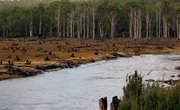The Phanerozoic eon is a geological period spanning the development of visible, or macroscopic, plant and animal life on Earth. It began approximately 543 million years ago at the beginning of the Cambrian period and extends to the present day. Species evolved, became extinct and left a fossil record in rocks and sediments. The five most severe mass extinctions during the Phanerozoic were cataclysmic events when over half of the existing species died out over a limited period of time.
Late Ordovician
This Late Ordovician extinction occurred 445 to 440 million years ago and wiped out 82 to 88 percent of all species. It was the second most severe of the major mass extinctions. At this time, the southern continents comprised a single mass, Gondwana, that drifted gradually from equatorial regions toward the south pole. The climate changed from tropical to the severest glaciation of the Phanerozoic eon. Sea levels fell and inland waterways were drained as water turned into ice. Life, including corals, graptolites and brachiopods, died out in shallow waters where most species lived
Late Devonian
The Late Devonian mass extinction occurred in two phases between 375 and 359 million years ago when between 79 and 87 percent of all species died. The fossil record shows that terrestrial plants and forests first appeared during the Devonian. In common with the same processes today, plants used up carbon dioxide in the atmosphere for photosynthesis, causing temperatures to fall. Vegetation boosted soil formation, rock weathering and the run-off of nutrients into the seas. An over-concentration of nutrients in water stimulated algal growth, used up oxygen, and led to extensive coral reef ecosystem collapse. Geologists believe that intense volcanic activity may have triggered a global cooling as dust and aerosols blocked the sun’s radiation.
Late Permian
The severest mass extinction occurred in the Late Permian period 251 to 252.2 million years ago. It lasted only 20,000 years and decimated over 95 percent of life on Earth in what became known as the “Great Dying.” Its causes remain a geological mystery. The extinction could have been triggered by massive volcanic eruptions on land in the region of today’s Siberia. Sulfates and carbon dioxide gases were injected into the atmosphere. Burning coal and organic matter on land added to the carbon dioxide input leading to a possible global warming of up to 6 degrees Celsius (34.5 degrees Fahrenheit). As the atmosphere and oceans warmed, they could have led to the melting of frozen methane deposits – gas hydrates – in marine sediments and their release into the atmosphere. This would have added further to the warming in a runaway greenhouse effect, as methane is a more powerful greenhouse gas than carbon dioxide.
End Triassic
Dinosaurs, amphibians, reptiles and mammals made their first appearance in the Triassic period around 250 to 200 million years ago as life recovered after the Permian extinction. Land consisted of one supercontinent, Pangaea, which had an arid climate. Toward the end of this period, sea levels fluctuated wiping out reef systems and shallow marine organisms. The period ended with mass rifting and volcanism as Pangaea began to break apart. This was the Earth’s largest known volcanic event and may have doubled carbon dioxide concentrations in the atmosphere. The increase in temperatures wiped out 76 to 84 percent of all species, including some amphibians and dinosaurs. In the tropics, temperatures on land are estimated to have been between 40 and 60 degrees Celsius (104 and 140 degrees Fahrenheit).
Cretaceous - Tertiary
The Cretaceous-Tertiary mass extinction -- also called the K/T extinction -- that occurred 65 million years ago is best known for the demise of non-avian dinosaurs and ammonites. Some winged dinosaurs survived and evolved into today’s birds. Mammals and amphibians were little affected. Geologists first explained its cause as due to a fall in sea levels that increased competition for food resources. A more recent explanation is impact of a 100-kilometer wide meteor on today’s Yucatan peninsula, Mexico. This may have caused an initial cooling as dust and aerosols blocked out sunlight. Later carbon dioxide released from the meteor’s incineration of carbonate rocks and vegetation is believed to have caused a massive global warming. Temperatures would have been raised by 5 to 14 degrees Celsius (29.5 to 82.6 degrees Fahrenheit) and 71 to 81 percent of all species are estimated to have been destroyed over about 8.8 million years. This extinction has been popularized in films and literature, but in geological terms, is no better understood than earlier cataclysmic events. Its causes could be a combination of factors, some still unknown.
Related Articles
References
- University of California Museum of Paleontology: The Geological Time Scale in Historical Perspective
- Natural History Museum: End-Ordovician Mass Extinction
- Natural History Museum: Late Devonian Mass Extinction
- Massachusetts Institute of Technology: Timeline of a Mass Extinction
- Natural History Museum: End-Triassic Mass Extinction
- New Scientist: Roasting Triassic Temperatures Exterminated Tropical Life
Resources
Writer Bio
Based in London, Maria Kielmas worked in earthquake engineering and international petroleum exploration before entering journalism in 1986. She has written for the "Financial Times," "Barron's," "Christian Science Monitor," and "Rheinischer Merkur" as well as specialist publications on the energy and financial industries and the European, Middle Eastern, African, Asian and Latin American regions. She has a Bachelor of Science in physics and geology from Manchester University and a Master of Science in marine geotechnics from the University of Wales School of Ocean Sciences.











